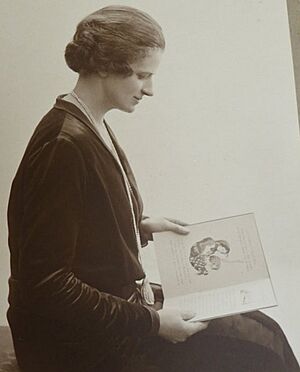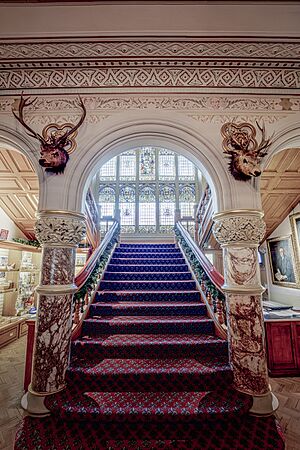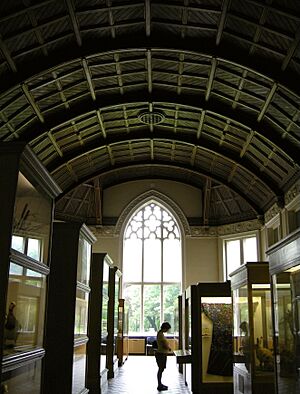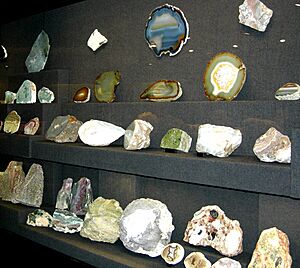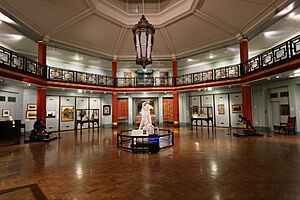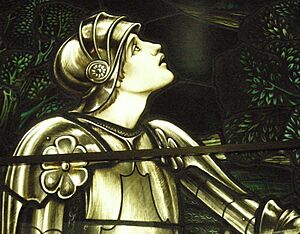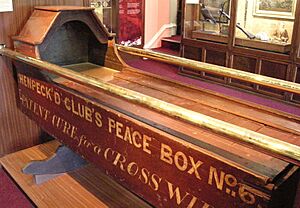Cliffe Castle Museum facts for kids
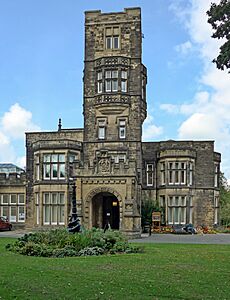
Cliffe Castle Museum, Keighley
|
|
| Established | c. 1892 as Keighley Museum at Eastwood House, Keighley. Reopened in 1959 at the former Cliffe Hall as Cliffe Castle Museum. |
|---|---|
| Location | Spring Gardens Lane, Keighley, West Yorkshire, England BD20 6LH |
| Type | Heritage centre, Historic house museum. |
| Visitors | 65,000 (2010) |
| Public transit access | Keighley railway station; bus information from Bradford Interchange |
Cliffe Castle Museum in Keighley, West Yorkshire, England, is a cool local museum. It opened in 1959 inside the amazing Victorian-style Cliffe Castle building. The building itself, called Cliffe Hall, was first built way back in 1828. The museum is like a newer version of the old Keighley Museum, which started in Eastwood House around 1892. At Cliffe Castle, you can explore different rooms that show off local history and the beautiful house itself. The building is so special it's even listed as a Grade II listed building.
Contents
A Look Back: The Castle's Story
It's thought that the first Keighley Museum began in 1893. That's when its first home, Eastwood House, was bought for everyone to enjoy. Later, in 1950, a kind person named Sir Bracewell Smith bought Cliffe Castle. He had it changed into a museum and art gallery for the people of Keighley. The museum then opened its doors as Cliffe Castle Museum and Art Gallery in 1959.
How the Castle Was Built
Cliffe Hall was built between 1828 and 1833 by Christopher Netherwood. It was designed by George Webster, an architect who liked the gothic revival style. In 1848, the Butterfields, a family who made textiles, bought Cliffe Hall.
Henry Isaac Butterfield made big changes to the building from 1875 to 1880. He added tall towers, a large room for dancing (a ballroom), and glass rooms for plants (conservatories). In 1878, he renamed it Cliffe Castle. He decorated the building with a special griffin design, which was his family's symbol.
By 1887, the Cliffe Castle Estate was huge, covering about 300 acres. Henry Isaac Butterfield's son, Sir Frederick William Louis Butterfield, later became the Mayor of Keighley. In 1918, he even hosted a visit from King George V and Queen Mary!
After Sir Frederick passed away in 1943, his daughter, Marie-Louise, Countess Manvers, inherited Cliffe Castle. She moved some of the castle's treasures to her home at Thoresby Hall.
In 1949, Keighley Corporation bought the castle and its grounds with help from Sir Bracewell Smith. He also paid for the house to be turned into a public museum in 1955. For the museum, some parts of the castle were changed. A back tower was removed, and the front one was made shorter. Some fancy roof decorations were taken down, and the conservatories were removed. Even though some of its original look changed, parts of the amazing inside were brought back to life. Later, many items that had been moved to Thoresby Hall were brought back to Cliffe Castle with help from the public.
Exploring the Museum's Rooms
Entrance and Main Rooms
When you walk into Cliffe Castle, the entrance and staircase show off a cool Victorian style inspired by old Gothic buildings. The roof over the staircase looks like something from the 1400s, and the staircase window looks like it's from the 1300s.
The beautiful window was made by Powells of Leeds. At the very top, there's a copy of a famous painting called Madonna and Child. In the entrance rooms, you can also see life-sized paintings of Napoleon III and Empress Eugenie.
Working Landscapes and Nature Galleries
The Working Landscapes gallery shows old local crafts and jobs. You can even watch a video about how wooden shoes (clogs) were made! The Airedale gallery explains how the River Aire was formed and shows fossils of its first animals. In the Archaeology Area, you can see the amazing Silsden Roman treasure.
The Natural History gallery used to be the Butterfields' ballroom. Now, it's filled with mounted animals and birds. You can see a family of tawny owls and even hear birdsong! There are many examples of animals prepared by a taxidermist here.
Molecules to Minerals Gallery
This display was created in 1988 and includes collections from several museums. It helps you understand how minerals are different from rocks. You can learn about mineral color, how hard they are, if they are magnetic, and their shapes. There are over a thousand specimens here, including some rocks that glow!
Sir Bracewell Smith Hall
This large space was created in the 1950s when the castle became a museum. In 2013, it was restored to its original colors. A special octagonal light fixture, designed for this space in the 1950s, was also put back. This hall now displays a permanent collection of interesting items from the museum.
The Egyptians Gallery
This gallery has a mummy of an Egyptian girl from around 250 BCE. It teaches you about the Ancient Egyptian belief in the afterlife.
Breakfast Room
This room downstairs is an easy-to-reach space that connects to themes you'll find upstairs.
Conservatory and Stained Glass Gallery
This room holds a few larger exhibits and is often used for teaching or activities. You can see a marble statue of the Virgin Mary and Child that once belonged to Henry Isaac Butterfield. There's also a wooden memorial plaque from World War I. The stained glass gallery has some of the earliest William Morris stained glass in the country.
Keighley Stories Gallery
This gallery tells the story of Keighley. It includes the Keighley Hen Pecked Club's peace box. This is a large, adult-sized wooden rocking cradle, supposedly for calming down nagging wives! It had funny rules and was shown at festivals. The gallery also has a Bees Gallery and a Costume Gallery, which shows different outfits from the museum's collections.
Mansion to Museum and Local Pottery Galleries
This gallery, located around the top of the Sir Bracewell Smith Hall, shows how the building changed from a private Victorian home to the museum it is today. A "Chinese Chandelier" with carved wooden harpies once hung in Cliffe Castle. It has been restored and now hangs in the Bracewell Smith Hall. The Local Pottery gallery celebrates a past local skill and trade that was important in the Keighley area.
More About the Museum
- The Friends of Cliffe Castle is a group that has helped a lot with researching and improving the museum recently. You can find a leaflet about them at the museum.
- Education Programme: Schools can book workshops and trails for different age groups. Sometimes, there are also activities for adults and groups with special educational needs.
See also
- Bradford District Museums & Galleries
- History of architecture
- Listed buildings in Keighley
- List of works by George Webster


